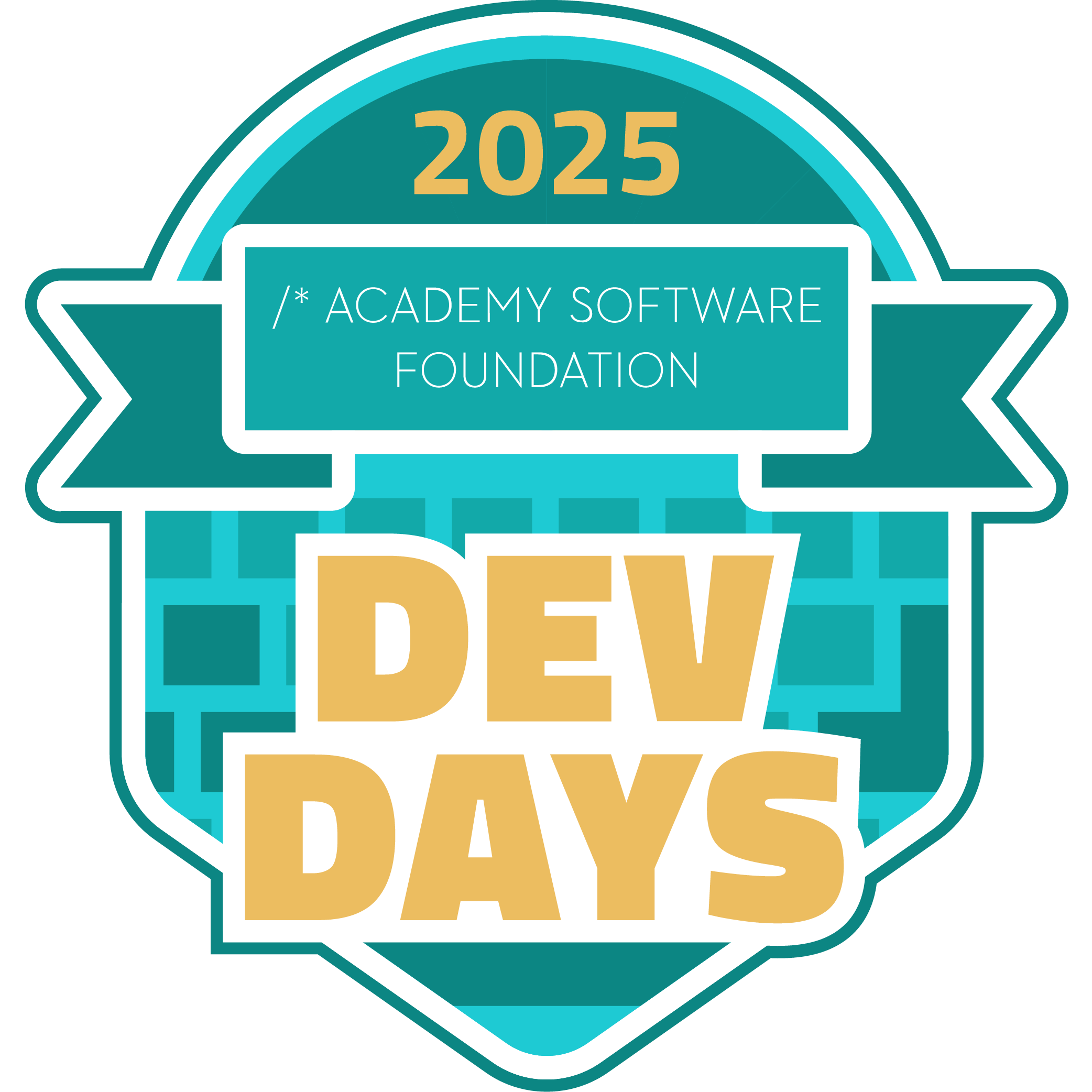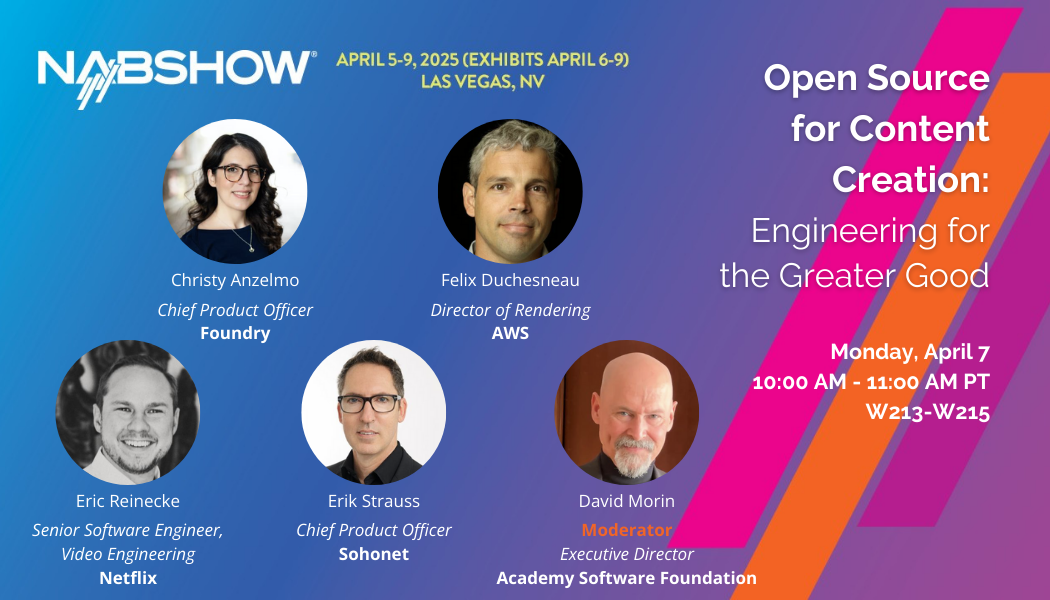At our recent Open Source Days event, we had the opportunity to speak with a cross-section of Academy Software Foundation members about the importance of open source technology and open standards for their businesses, and the value that they derive from contributing to the Foundation’s open source projects and collaborating with fellow members across the industry. From creative studios to software developers, these speakers offered thoughtful insights about the open source landscape and benefits of open industry-wide collaboration.
Thank you to Paul Salvini (Global Chief Technology Officer, DNEG), Larry Gritz (Software Architect, Sony Pictures Imageworks), Andrew Pearce (VP of Global Technology, DreamWorks Animation), Mathieu Mazerolle (Director of Product for New Technology, Foundry), and Maurice Patel (Director of Industry Strategy, Autodesk) for taking the time to share your thoughts.
We’ve compiled some highlights from our extended conversations below. You can also check out our member reel for more:
For the studio representatives, open source tools and standards are key to their continuing success and collaboration with their peers across the industry. At DNEG, Paul Salvini shared that Academy Software Foundation projects such as OpenColorIO, OpenEXR, and OpenVDB play an instrumental role in their technology stack, and make it much easier to collaborate with other studios on major VFX films as needed. DNEG is also a contributor to both the OpenColorIO and OpenVDB projects.
Larry Gritz noted that Sony Pictures Imageworks also relies heavily on open source software in their VFX technology stack, and that ensuring the continued development and attention to their contributed projects – including OpenColorIO, OpenCue, and Open Shading Language – was a major motivation for them to join the Academy Software Foundation. He shared that their participation has significant advantages for the studio: “We view our participation in this as helping to steer the direction of these projects that we’re reliant on, in the direction that’s going to be useful to us as well. We know it’s continuing to develop along the lines that we’re going to need for our future as well.”
Andrew Pearce agreed that open source is crucial for DreamWorks Animation, which originally developed and contributed OpenVDB to the Academy Software Foundation. He added that the use of open source projects helps the studio save costs and engineering resources by not having to create as many custom tools for common needs that can be standardized.
Salvini concurred, saying: “One of our goals as a company is to rely on as many industry standards as we can. We want to be able to focus our R&D efforts on things that provide uniqueness, unique value, differentiation, strategic focus, so it’s amazing if we can have standard tools agreed upon by the industry and developed in conjunction with other partners in the industry. The more we can do that, the better off we are as an organization.”
These members also agreed that having the Academy Software Foundation as a neutral forum to manage the ongoing development of these open source projects, which were previously proprietary to individual studios, is a huge benefit to the broader VFX and animation industry. In addition, the opportunity for multiple studios and software developers to all come together in service of a common goal, with benefits for all, is a major draw. Salvini noted that he enjoys the chance to interact with his wider industry peers on a regular basis, and Pearce added that the community factor is a key selling point for studio executives, because decentralizing the support and development of a given project provides the studio with a tangible return on investment.
On the software vendor side, Maurice Patel from Autodesk shared that the broader collaboration helps them more efficiently solve challenges for customers, deliver in-demand features, and move the industry toward greater adoption of open standards. He said, “When the Academy Software Foundation was created we joined as a founding member because we fundamentally believe that this was the right approach to solving that problem of how do we get the industry to align. For certain things you don’t need to be custom, it doesn’t need to be so bespoke, there are certain things that we can work together as an industry to make a standard that makes it easier for everyone.”
Foundry’s Mathieu Mazerolle agreed, adding that: “We really saw the Foundation as a critical piece in what was required to evolve the way we collaborate more broadly across the industry on really important open source projects. I also like that the Academy Software Foundation is able to find time to think strategically about how we can grow the set of things that we bring into the fold to benefit the industry.”
Ultimately, each member sees value in their participation in the Academy Software Foundation, as they have visibility and transparency into major industry trends, what kinds of things are steering different projects, and can ensure that each project has ongoing support and attention.
As the Foundation continues to grow, the members concur that having a variety of voices in the room will only help strengthen the stability and feature sets of each project. Studios and software developers of all sizes, from all regions, help provide crucial new insights and coding contributions to benefit the broader community. Additionally, more and more new Working Groups are being developed – such as the Review and Approval Working Group, Rust Working Group, and Diversity & Inclusion Working Group – so there are more ways than ever to get involved. As conversations continue among Academy Software Foundation members, the opportunities increase for new open source projects to organically develop across multiple member companies, rather than being developed in-house and then contributed.
To learn more about how your company or organization can get involved with the Academy Software Foundation and ensure a healthy open source ecosystem, please visit https://www.aswf.io/join/.


